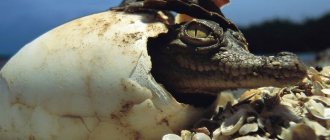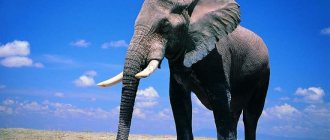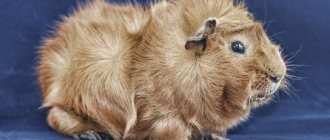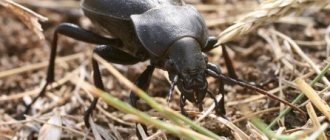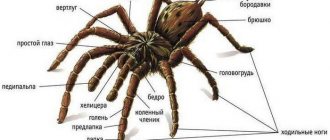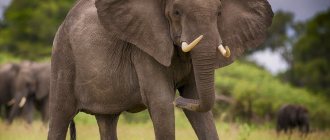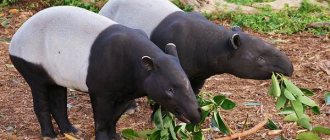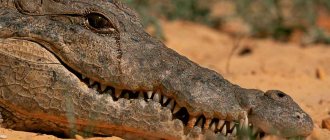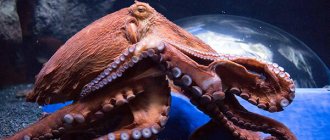Proboscideans are an order of placental mammals that includes elephants and their extinct relatives. All representatives of the order have a trunk, which performs various functions, including capturing food or water, moving objects, and interacting with other relatives. They also have specialized teeth for chewing vegetation, as well as tusks (second upper incisors) used for clearing tree bark, digging in the soil for food, and fighting.
Classification
Currently, two living genera are distinguished in the order Proboscidea:
- African elephants (Loxodonta) include two living species: savannah and forest elephants.
- Asian elephants (Elephas) include one living species: the Indian elephant.
Some extinct representatives of the order Proboscidea include:
- The Moeritheridae family are animals that were characterized by their small height at the withers (about 70 cm) and a weight of approximately 235 kg.
- The Deinotheriidae family are the largest representatives of the order, weighing more than 10 tons.
- Family Gomphotheriidae - most species had elephant-shaped trunks, but they differed from elephants in the structure of their teeth and the number of tusks (some had 4 tusks).
- The mastodon family (Mammutidae) included 3 genera. Some members of the family had a height at the withers of about 3 m.
- Elephant family (Elephantidae) - includes mammoths, elephants and stegodon.
Kodiak
Bears will not be lost among terrestrial carnivores: both the polar white and the Kadyak (brown Alaskan) are considered not only the most dangerous, but also the largest. They can be said to be the same in size: from one and a half meters high and above, more than three meters long. A polar bear in some specimens weighs about a ton, and a brown bear can be heavier. He lives only on the islands located south of Alaska, and the bear got its name from the archipelago (Kodiak). He is a close relative of our brown bears, but much more massive than our usual forest bear, and even the grizzly bear. On average, a Kodiak weighs five hundred kilograms, but about thirty years ago, to its misfortune, a beast weighing 1,150 kilograms met with people. Very dangerous and always attacks. He only seems clumsy, but in reality he is surprisingly agile and very cunning. A person always feared for his life when his path passed through the territories where the Kodiaks live. Therefore, any aggressive animal encountered was almost always killed. Thus, the entire already small population was almost reduced to nothing. Since 1941, it has been prohibited to kill Alaskan bears, and therefore today you can count three thousand individuals.
Evolution
The first proboscideans evolved and diversified in Africa during the Paleogene period. Phosphatherium escuilliei is the earliest recognized ancestor of proboscis from the late Paleocene (58 million years ago) in Morocco. Its height at the withers was less than a meter. Moerteryium is another early proboscis that was the size of a large pig and probably did not have a trunk, although it is thought to have a mobile upper lip. In Egypt, Algeria, Libya and Senegal, fossil remains of two species of Moerteryium (M. lyonsi and M. trigodon) were discovered in the late Eocene.
Other proboscidean ancestors include Numidotherium, Barytherium, and Deinotherium. The remains of these early proboscideans were discovered in northern Africa along the southern coast of the Tethys Ocean, which existed in the Mesozoic era. Numidotherium grew about 1.5 meters in height and had a trunk as long as a tapir. Many remains of this early proboscis were obtained from middle Eocene deposits in Algeria.
There were two types of bariteria. One species was large, weighing about 3-4 tons and 2.5-3 meters high. The second species was smaller, about the size of Moerteryium. Barytherium lived from the late Eocene to the early Oligocene. Deinotherium had a fully functioning trunk and tusks on its lower jaw. Deinotheres roamed the planet for 20 million years, living in Africa, Europe and Asia, starting in the mid-Miocene; they survived in Eurasia until the Pliocene and in Africa until almost a million years ago.
Throughout their history, proboscideans have shown a tendency to increase in size. The earliest known members of the order were moderately large, probably weighing around 120 kg; modern species are very large (an adult male African elephant can weigh more than 6,000 kg). The largest extinct member of the proboscis order, the steppe mammoth (Mammuthus trogontherii) was a huge animal, weighing about 9,000 kg, which is 1/3 more than the weight of African elephants. Early proboscideans had neither a trunk nor tusks. These body parts appeared during the evolution of animals.
Why does an elephant need a trunk?
The trunk is an important and irreplaceable organ of elephants. It was formed by the connection of the upper lip and nose. Equipped with muscles and tendons that allow the animal to use it instead of arms. Using this powerful and flexible tool, proboscis mammals can drag branches, logs, and pick fruits from trees.
The trunk also works as a sensory organ. The nostrils located at its end help to smell odors. Thanks to the sensitivity of the trunk, elephants feel objects to recognize them. At a watering hole, they suck up water with their trunk and then put it into their mouth. The sounds produced by this organ allow elephants to communicate.
Description
Modern elephants have a long, muscular trunk that functions almost like a fifth limb. Male Asian elephants and female and male African elephants have a pair of huge canines (tusks), which are growing incisors of the upper jaw.
Their teeth are uniquely adapted to roughage. As was the case with their ancestors, modern elephants have 6 molars. However, in modern elephants, the first three teeth are small and relatively simple. The fourth begins to grow at 4-5 years. It gradually moves forward of the jaw and after eight years is replaced by a fifth tooth. The sixth tooth begins to grow when the elephant reaches about 25 years of age.
The skull of modern elephants is short and high. The skeleton of these mammals is adapted to attach huge muscles that the animal needs for nutrition, self-defense and uprooting trees. The limb bones are strong, and the toes extend and are supported by a pad of dense connective tissue.
A distinctive feature of these animals is their huge ears, with the help of which they regulate body temperature and perfectly capture sounds at long distances.
Elephants live a long life (60-70 years).
Both nose and hand
The main thing that distinguishes elephants from other mammals is their fused nose and upper lip—the trunk. Strictly speaking, the trunk is not a unique feature of the elephant. Many animals have elongated, mobile proboscis, for example, jumpers or raccoons, but for no one is the trunk as vitally important as for the elephant.
African elephants
An elephant's trunk is primarily a nose. Along its entire length it is divided by a longitudinal partition, and the trunk ends with two “fingers” processes. With these sensitive “fingers” an elephant can pick up a speck from the ground and even remove a parasite from its skin. Elephants use their trunks to grab food and tear grass from the ground or leaves from trees. The elephant drinks with the help of its trunk, and by drawing water into it and dousing itself, the animal takes a shower. Elephants love water treatments and swim well. Submerging almost entirely in water, they use their trunk as a breathing tube. With the help of a strong trunk, an elephant can lift logs and repel attacks from predators. A powerful blow from the trunk can break the backbone of a tiger or lion. By blowing its trunk, the elephant gives various signals to its relatives and scares away the enemy.
A trunk for an elephant is more important than a hand for a person, because if a person loses a hand, he will survive, but an elephant that loses its trunk will inevitably die.
Diet
Elephants require a huge amount of food, more than 150 kg per individual per day. They are capable of knocking down large trees to get their leaves and bark. Elephant herds can damage arable land or forests while feeding.
The diet of these animals consists of grass, leaves, tree bark, branches, roots, fruits, etc. Tree bark is a favorite source of food for elephants. It contains calcium and is a roughage that aids digestion.
Elephants require between 68.4 and 98.8 liters of water daily, but can consume up to 152 liters. An adult male can drink up to 212 liters of water in less than five minutes.
Saltwater crocodile
12881
The real sea devil is the saltwater crocodile, which is the largest reptile in the world. It causes fear and horror on the coasts from eastern India and southeast Asia to northern Australia. There is hardly a person who is not afraid of such a monster: a saltwater crocodile with a length of five to seven meters weighs from half a ton to one and a half tons! However, despite its terrifying appearance, it has long been the object of the most ruthless hunt by man. A bag, clothes or shoes made of crocodile skin has an exorbitant price, almost like a jet plane. And man is a greedy creature, unfortunately. And this prehistoric animal, the saltwater crocodile, was very close to complete extinction. But a way out was found. Now these predators breed in captivity on special farms, because people have invented ways and methods for the development of such a fishery. Despite the fact that not a single animal can fight back a saltwater crocodile either in water or on land, in the wild this species is quantitatively decreasing and may become extinct, like many of its counterparts in prehistoric times.
Reproduction
Puberty in males occurs at the age of about 14 years, but males who have reached 40-50 years of age most often breed with females. Females tend to run away from males, and this game of cat and mouse can go on for a very long time before actual mating occurs.
Males rarely fight for the right to mate with a female. As a rule, young ones give way to older males. There is much speculation that this is not out of fear, but out of respect.
Elephants have a long gestation period of about 22 months. Cubs can weigh up to 120 kg at birth.
After birth, the baby elephant receives care and protection from its own mother, as well as from other females of the herd. Parenting together allows new mothers to eat well and produce nutritious milk for their babies. Baby elephants can drink up to 40 liters of mother's milk every day.
It is believed that the offspring of elephants do not have the same high level of survival instincts as other animals. This is why cubs rely so much on their mothers and other females in the herd. They learn faster and acquire new skills all the time.
Black rhinoceros
2443
In all respects, this species is slightly inferior to its white counterpart: the black rhinoceros rarely weighs more than two tons, the body grows up to three and a half meters in length, and up to about one and a half meters in height. Poachers confidently destroy this wonderful animal, since the rhinoceros has poor eyesight, and therefore it rarely changes paths. Apart from humans, he has no enemies; fear is not inherent in his instincts. All this makes the black rhino an easy prey. And if a white rhinoceros is not white at all, then a black one cannot be called black either. Of course, if he rolls out in the mud, which he loves to do, and if instead of soil there is crushed lava under his feet, then the rhinoceros’s skin may acquire a blackish tint. And initially it is gray, light, slightly darker than that of a white rhinoceros. In the places where these animals live, the ground is much more often yellowish or reddish, so it is almost impossible to meet a completely black rhinoceros in Africa, but it is easy to find a red one.
Number
The African elephant population is estimated to be between 400,000 and 660,000. The IUCN lists the African elephant as critically endangered.
Currently, all Asian elephant subspecies are classified as endangered by the IUCN, with a total population size of between 25,600 and 32,750 individuals. The Asian elephant subspecies, the Indian elephant (Elephas maximus indicus), is the most numerous (20,000 to 25,000 individuals).
Giraffe
4686
This graceful animal seems so slender compared to elephants and hippos! However, a male giraffe weighs more than one and a half tons! In addition, no animal on the planet has grown taller than a giraffe. Six meters from head to toe, and almost half of this length is the neck. The females of this African resident weigh half as much, are even more refined, every movement is like that of a ballerina. I can’t even believe that this elegant beauty is carrying, as if through the air, at least eight hundred kilograms of her own weight. Giraffes can reach speeds of more than fifty kilometers per hour. And if you can’t escape from a predator, a kick from a long, chiseled leg can knock down a lion.
Text: Lyudmila Garkavaya
← The most important pets↑ The most-most animals Whose family is the most friendly? The most faithful animals →
